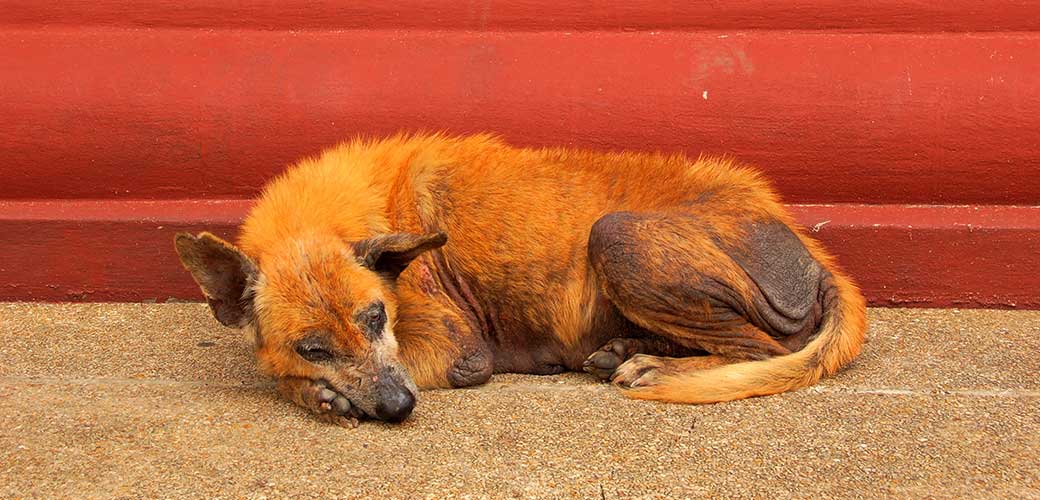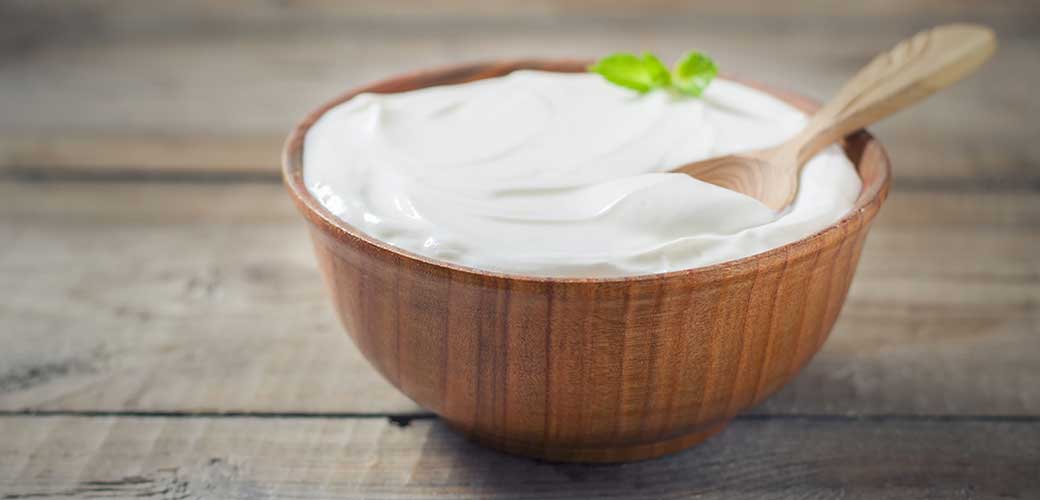Dog ownership can be challenging at the best of times so the development of a health issue can be worrisome. Canine mange is a common skin disease that can strike unexpectedly. It can be irritatingly painful for your dog to endure so you may be wondering what the best course of action is to help soothe and treat your canine companion.
Below, we have everything you need to know about mange including the different types, symptoms, how your dog can develop it, and what home remedies you can use to help dogs suffering from skin disease.
What is Mange?
Mange doesn’t just occur in dogs and cats as birds, reptiles, plants, and even people can be infected. Put simply, mange is a terrible skin disease caused by a mite infestation. When an infestation occurs, microscopic parasites invade and reside on your dog’s skin often burrowing beneath the initial layer of skin and even within the hair follicles to lay eggs and feed on the skin cells.
There are different types of Mange that can specifically affect dogs. Below you find out more about these types and how to treat them.
Types of Mange in Dogs
There are two well-known types of mange that affect dogs. These are Sarcoptic Mange and Demodectic Mange which can have painful and irritating symptoms when your dog becomes infected. There is also a less common type of Mange called Cheyletiellosis Mange that can still affect canines although this is rare.
Sarcoptic Mange
Otherwise known as canine scabies, Sarcoptic Mange is where Sarcoptic mites burrow beneath the layers of your dog’s skin to lay their eggs in order to reproduce. Often, they will reside on one area of your dog’s body but will quickly reproduce and infest the other areas if not treated quickly. Typically, these parasites will initially burrow into the skin of a dog’s ears or belly, as they tend to prefer hairless skin.
Highly contagious, the Sarcoptes scabiei canis can infest an array of animals and can even attack healthy adult people.
Sarcoptic Mange Symptoms
The primary symptoms of Sarcoptic Mange can include the following:
- Intense itching and irritated skin
- Hair loss
- Scabbing/crust formation
- Stubborn rashes
- Yeast/Bacteria infections
- Thickening of the skin (rare)
- Emaciation (rare)
Small bumps may also be visible in the areas that the mites have colonized. These areas are also the zones in which scabbing/crusting may appear.
Demodectic Mange
Officially called Demodicosis, this type of mange is caused by mites known as Demodex Canis. Unlike Sarcoptic mange mites that burrow beneath the dog’s skin, these particular mange mites live within the hair follicles and often don’t pose a threat to canines. In fact, a lot of dogs already have a few of these parasites and do not even know it as their immune system protects them and keeps them at bay.
However, this doesn’t mean that the Demodex cannot cause problems at all. These mites will increase in number and begin to cause harm when a dog’s immune system isn’t performing at peak capacity. Therefore it’s common to see this type of mange in puppies when their immune system hasn’t fully developed.
Having said this, it can also develop if the dog’s immune system is compromised later in life too as it has been known to affect senior dogs whose systems are beginning to falter. Fortunately, unlike Sarcoptic mites, Demodectic mange is not contagious.
Demodectic Mange Symptoms
When the immune system begins to collapse, the mites will then start to reproduce causing inflammatory changes including:
- Hair loss (usually starting around the paws and eyes)
- Skin redness
- Rough/dry skin texture
- Irritated skin
- Pustules on the skin
- Warm skin
If left untreated these symptoms can become a lot worse. The itching will become more severe which will lead to more hair loss and the skin can become crusted which is painful for dogs. In addition to this, if the skin is frequently damaged and exacerbated by itching, scratching, and gnawing your dog could also develop a skin infection.
Cheyletiellosis Mange
Cheyletiella yasguri mites are responsible for this type of mange and can have very similar symptoms to those previously discussed. This skin disease is also known as ‘walking dandruff’ as the mites are white in color and look like moving, flakes of dandruff.
With the current effectiveness of modern flea treatments, this type of mange has become somewhat rare. However, if it does occur it can simply be treated with over-the-counter medication.
Symptoms of Cheyletiellosis Mange
- Scaly skin
- Dandruff
- Pruritus (variable severity)
- Itching (variable severity)
How Dogs Get Mange

Sarcoptic Mange:
This type of mange is highly contagious and can be passed from one dog to another. It could even be passed on by other warm-blooded animals such as foxes. When a female mite makes it to another host, she will burrow into its skin and lay her eggs. These typically take around three weeks to hatch. Soon after the symptoms will begin to become more and more apparent.
Cheyletiellosis Mange:
This is another type that can be transmitted between dogs and other animals. Luckily, it is rare and easily treated.
Demodectic Mange:
This is commonly passed to puppies from their mothers not long after they are born.
How to Tell If Your Dog Has Mange
With the symptoms of the different types of mange at hand above, you may be able to spot the signs of infestation easily. However, a veterinarian will be able to firmly identify the presence of mites and eggs by analyzing skin scrapings taken from your dog.
In some cases, the mites and eggs can go undetected by a vet however the symptoms will still point to mange. Appropriate treatments can be bought and applied including over-the-counter products. Having said this, there is a number of home remedies that can be sought out and applied to help eliminate the problem.
How to Treat Mange in Dogs
If mites are evident following your trip to the vet, dog owners will be able to purchase medications to help eradicate the problem. However, there are several things you can use at home to treat mange.
Home Remedies for Dog Mange
Below we have several dog mange home remedies that can help you get rid of the infesting parasites.
Olive Oil

Although primarily used for cooking, olive oil has lots of other uses. Olive oil is beneficial when treating localized mange by applying a layer to your dog’s skin. By using a thin layer of oil, you will not only smother larvae and mites but can also help to soothe and hydrate the affected area of the skin.
Note: Olive oil is effective when treating localized affected areas and is not recommended to treat more severe cases. Not only will this be messy and expensive but you may also not guarantee that the problem will be completely eradicated.
Yogurt

Unsweetened, plain yogurt can also be applied to the affected area although it’s entirely possible that your pooch may get a sniff and want to lap it up. This isn’t a problem as plain yogurt is packed with healthy probiotics but it can prevent and slow down the recovery process.
Similar to treating mange with olive oil, yogurt should help to smother mites. However, it is recommended to treat small areas of infected skin only as it might be difficult and expensive to cover your dog’s entire body in yogurt.
Using Yogurt to Treat The Skin Irritation
Apply a tablespoon or two of plain yogurt to your dog’s skin and leave it for 15 minutes. After the duration has passed, wipe it away. You can use this multiple times a day although you may have to take steps to prevent your dog from licking it away.
Apple Cider Vinegar

Apple cider vinegar has proven in the past to have some benefits when treating skin problems, with some referring to it as a ‘miracle cure’. In this case, it can also be used to treat mange, although it’s not proven to be the best method when compared to others.
Unlike the previous home remedies, this option can be used inside or out. However, some sources argue that applying apple cider vinegar is more effective than adding it to your dog’s food or water bowl. This is because it may take some time for the addition to start taking effect
Using This Remedy
1. Dogs over 30 pounds: Add one tablespoon to the dog food or water.
2. Dogs under 30 pounds: Add one teaspoon to the dog food or water.
3. Bathing: Mix half a cup of apple cider vinegar with half a cup of borax and warm water. Ensure the mixture is dissolved and that your dog does not ingest any as the borax can be harmful internally. Keep the mixture away from their eyes and mouth when sponging in your dog’s coat and skin.
4. The mixture detailed above can also be used for smaller affected areas without having to coax your dog into the bath. Simply use the same mixture and decant it into a spray bottle. Then use the bottle to apply the liquid to the areas of the affected dog.
How long does it take to cure mange with apple cider vinegar?
This can depend entirely on how often you use this home remedy and how severe the affected spots are. Due to the antibacterial properties of the vinegar, it could be sooner than you might anticipate but it’s always worth getting a second opinion. This may mean taking your dog to your vet to offer an additional skin scraping but it’ll be worth it to see your dog’s health improve.
To learn more about the uses of apple cider vinegar, take a look at our article found here.
Aloe Vera

Being a natural antiseptic and anti-inflammatory, aloe vera can prove to be an effective home remedy for dog mange. Infected dogs will often experience intense itching and aloe vera can help to soothe the skin and provide relief.
Not only this but applying the aloe vera can smother the microscopic mites. Aloe vera also contains anti-parasitic compounds which will assist hugely when ridding your dog of mange.
Using Aloe Vera:
Gently apply bottled aloe vera twice a day until the mange has healed. Make sure to massage it into your dog’s skin and coat evenly.
Alternatively, you can also use the plant itself. Simply cut the leaf open and use the gel that oozes from within the plant. However, you must not allow your dog to ingest the leaf as it can be toxic to them. The gel itself will have a bitter taste, but it’s completely harmless for your dog and can even deter them from licking off the gel after application.
Honey

This is another one of our home remedies that can soothe irritated skin for those poor dogs that can’t stop scratching and gnawing. Its thick consistency, as well as its antibacterial and antifungal properties, will also effectively suffocate larvae and mites preventing them from reproducing.
Using Honey for Mange Treatment:
Organic, raw honey is one of the safest home remedies for dog mange. All you will need to do is apply it to the area affected and leave it for 15 minutes. Do this twice a day and ensure you wipe away the honey after the suggested duration.
Honey is also pretty delicious to dogs as well as people. So if you opt for this remedy, make sure your dog isn’t able to lick it off once you’ve applied it.
Lemon

The acidity of the lemon will help to terminate mites, larvae, and eggs. The strong scent is also likely to repel mites in the future. Not only this but it is also said to eliminate some fungi and bacteria too as a number of citrus fruits contain antiseptic properties.
Using Lemon for Mange Treatment
Various sources will instruct different methods of applying this home remedy to your dog’s skin. Here we have two of the most common and effective alternatives:
Combine the juice of a single lemon mixed with one liter of water. Decant the mixture into a spray bottle and apply it to the area.
Including the peel, cut one lemon up and mix it with boiling water. Leave the water overnight then apply the mixture to your dog’s coat and skin using a sponge.
Mix 3 tablespoons of lemon juice with 2 ounces of witch hazel. Combine this with 4 ounces of water. Apply this combination to the area with a sponge.
Using Lemon With Garlic
Some sources say that fusing garlic and lemon together is a practical way of eliminating mange. To do this, you must mix six to ten cloves of garlic with half a cup of water. Then add one lemon peel to the infusion and let this sit overnight.
Safety Note:
Reconsider using this home remedy if your dog’s mange contains open wounds, abrasions, or sores as the acidity could irritate them and potentially cause or exacerbate skin infections. It is also likely that the juice can also kill healthy bacteria as well as bad bacteria and fungi.
This option is a good choice for many reasons however we recommend considering other options beforehand.
Know When to Use Natural Remedies for Dog Mange
Although these products can be extremely helpful, as a dog parent it’s important to recognize when medical attention is needed. If you try the following methods above and you see no improvement, consult your vet.
Other Actions to Take When Treating Mange
As pet owners, it can be daunting to tackle such a problem. Your first port of call would be to contact your vet so you can come to a conclusion on what method is best to treat your pooch.
When treating such issues there are other things you must do to ensure that the problem completely goes away and won’t threaten you and your canine companion again in the future. Below are some additional tips to consider when combatting dog mange in addition to any home remedies or treatments you are using.
Frequent Grooming

Pamper your canine companion with a warm soapy bath. If you can’t get your hands on a medicated shampoo, make sure to use a gentle shampoo and conditioner that will nourish and soothe your dog’s skin. Shampoos containing colloidal oatmeal are often recommended for dogs with skin problems.
Bathing won’t just soothe irritated skin it will also help to remove dead skin and hair from their coat too. Bathing will also help to improve the appearance of your dog’s coat and may also reduce any emitting odors.
Medicated Dog Shampoo
If you’re looking to use a medicated shampoo make sure you clarify with your vet what features to look for when purchasing one. Medicated shampoos are used to treat a number of ailments so make sure you get the best option for treating dog mange.
Brushing
Brushing your dog is another way to rid their coats of flaky, dead skin and loose fur. Frequent brushing can also help rid the coat of unsuspecting mites.
Cleaning and Maintaining Furniture and Carpets
Some types of dog mange will leave mites on areas where your dog tends to relax. When treating the problem it’s worth thoroughly vacuuming and steaming your upholstery and carpets. This will reduce the chances of your dogs contracting the mites again.
Clean Your Dog’s Bedding
Much like the upholstery and carpets, mites will invade territories frequented by your pup including their bedding. Make sure to effectively clean dog crates, blankets, cushions, bedding, or any other comfy spots your dog likes to relax and sleep in.
Persistence is Key
It’s important to note that cleaning these things or bathing your dog once won’t eradicate the problem. Make sure you do these things frequently. This way you can be sure that the mites are less likely to survive and bring the problem back.
Diet
As dog lovers, you will know that a nutritious diet will provide your dog with everything they need to support them inside and out. A good diet will help to strengthen their immune system and stave off Demodex mites that may already be present. Regular, healthy meals will also help to keep them energized.
Supplements can also provide a little extra support. When considering adding vitamins to dog foods, consult your vet to ensure that it’s necessary as too much or too little could cause problems.
CBD

CBD has proven to be another option to help relieve dogs of itchy or irritating skin. It can also help relax dogs that are feeling particularly stressed or anxious as a result. With these things in mind, this will also help strengthen the immune system and allow it to function better overall, aiding your dog’s recovery.
Before resorting to this method, make sure you can introduce it to your dog safely. Take a look at our guide to learn more about safe CBD oils for dogs here.
What Happens When Dog Mange is Left Untreated
If mange isn’t treated properly there are a few things that can occur as a result. The most common complications can be the transmitting of demodectic mites to humans and/or other pets along with fungal or bacterial infections.
Bacterial and fungal infections will occur after a long period where your dog has been allowed to scratch or gnaw irritated areas. Biting and scratching will encourage the skin to tear and break allowing access to harmful infections.
Depression/Lethargy/Weight Loss
It’s important to also understand that these skin infections can also leave dogs experiencing depression, anxiety, or lethargy. As a result, they may suffer from a lack of appetite leading to weight loss down the road.
How to Get Rid of Mange on Dogs – Summary
After reading about the symptoms and understanding the terrible effects of mange, it’s always important to take your dog promptly to your vet. Since mange can vary from case to case, your dog may benefit from the recommendations above. However, always monitor your pup closely. If you fear the problem is spiraling, consult your vet.

